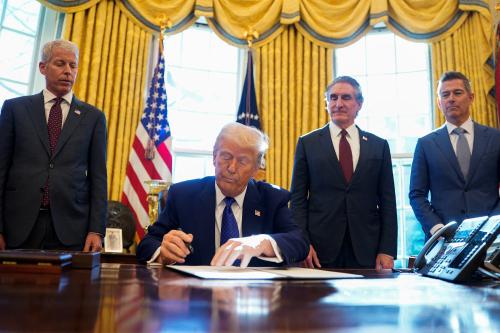The COVID-19 pandemic—in addition to posing a severe threat to public health—has disrupted the economy and financial markets, and prompted a strong desire among investors for safe and liquid securities. In that environment, one might expect U.S. Treasury securities to be the investment of choice, but for a while in March, the $18 trillion market was surprisingly dysfunctional. Here’s what happened and why.
What are Treasury debt securities?
The federal government borrows by issuing Treasury debt securities, considered the world’s safest and most liquid securities. They serve as a store of value, a hedging vehicle for global savers and investors, and the benchmark against which other forms of lending are compared.
Treasury securities—known as bills, notes, and bonds depending on the maturity—are sold by the Treasury in auctions, which determine the interest rate it pays to borrow. In calendar year 2019, the Treasury conducted 322 public auctions, rolling over maturing debt and adding about $1 trillion to fund a widening federal deficit.
Treasuries are very actively traded in the secondary market—an average of nearly $600 billion in daily transactions last year. Most of that activity was in “on-the-run” securities, those auctioned recently and easiest for markets to value. This makes them a common instrument for hedging and speculation. Older securities, known as “off-the-run,” are generally held in portfolios as investments and, thus, traded less frequently and can be harder to value. (A 10-year Treasury note auctioned this week is “on-the-run.” A 10-year Treasury auctioned a year ago is “off-the-run.”)
Treasuries are widely held. As of April 2020, of the $18 trillion outstanding, $3.5 trillion were held by U.S. households, companies, and governments, $3 trillion by asset managers, $2.5 trillion by the Federal Reserve, and $2 trillion by banks and insurance companies. Nearly $7 trillion (40 percent) were held overseas, mostly by foreign central banks.
Treasury securities are at the core of financial markets. The yield on Treasury debt, considered to be free of credit risk (the risk of nonpayment), is a key benchmark for many other financial assets. The securities are also critical to short-term lending. Trillions of dollars in overnight loans use Treasuries as collateral. And they are rainy day assets: safe and stable investments that banks, companies, and governments accumulate on the assumption that they can be quickly sold at low cost if they need cash fast. This means that disruptions in the market for U.S. Treasury debt can quickly spill over to the rest of the financial system. Such disruption not only influences the interest rate at which consumers, businesses, and state and local governments borrow, but—in the extreme—can make it difficult for them to borrow at all.
What started the dysfunction in March?
The market for U.S. Treasury securities is usually deep and highly liquid, meaning investors can buy and sell large amounts (depth) of securities at short notice without materially affecting the price (liquidity). Market participants—banks, insurance companies, pensions, asset managers, mutual funds, hedge funds, and others—rely on the ability to easily sell their holdings in order to meet demand for cash. But in March, as financial markets came to terms with the damaging effects of COVID-19, investors rushed out of Treasuries and into cash. In some cases, this reflected their investment objectives—selling Treasuries to buy depressed equities, for example—but in others these sales were forced by losses on other positions or the need to settle short-term debts, and the market proved unable to handle the surge in Treasury sales.
What were the symptoms?
Depth and liquidity disappeared, prices became extremely volatile, sellers had trouble finding ready buyers at a reasonable price, and vice versa.
The specific symptoms included:
- Extreme difficulty in executing even modestly sized transactions;
- Very large increases in transaction costs;
- The price of derivatives, specifically Treasury futures, became unmoored from the bonds to which they are linked;
- On-the-run and off-the-run prices became so volatile that pricing became extremely difficult.

What caused this?
Uncertainty: The speed at which the economy deteriorated in March caught nearly everyone by surprise. This caused market expectations of asset values to shift rapidly, increasing price volatility.
High leverage: Large scale deleveraging exacerbated the dysfunction. The size of the leveraged fund industry is hard to calculate precisely, but a common proxy is the size of short-term borrowing done in the market for repurchase agreements (repo). Daily volumes in the overnight repo market have doubled since 2016. When this position started to unwind (i.e. traders closed their trades), it precipitated more selling as investors with exposure rushed to be the next out the door. This triggered waves of heavy selling into an already dysfunctional market, causing a vicious cycle of losses and additional selling.
Regulations: Banks and dealers are central to the business of trading. They make markets by buying and warehousing assets to facilitate the eventual matching of buyers with sellers. Since the global financial crisis, however, they have been less willing to warehouse assets for long periods, in part because of post-crisis regulations. As selling of Treasuries picked up in March, banks and dealers faced balance sheet constraints and internal risk limits amid the elevated volatility. This led to higher costs for even modest transactions and crowded out their ability to intermediate in other asset classes such as credit and municipal debt.
Working from home: Market functioning was impaired in part because traders are working from home. Some trades require coordination among several counterparties and is thus operationally demanding. In normal times high-speed algorithmic traders act as market makers, buying and selling securities quickly. But these traders tend to evaporate when conditions are turbulent. Human traders provide a backstop in such times. And other activities, including short-term collateralized lending, central to the smooth operation of the payments and financial system, can be difficult to run remotely.
What were the issues in the market for Treasury futures?
Some parts of the markets for U.S. Treasuries are more liquid than others. Treasury futures—derivative contracts constituting a commitment to buy or sell Treasuries on some future date—are generally more liquid than the Treasury securities themselves. There are several reasons for this; the most important is that they offer exposure to Treasuries while committing only a small fraction of the cash now.
In theory, the price of a Treasury futures contract should be closely tied to the bonds that will eventually be delivered, but the usual tight link between these two prices broke down in March. That posed a challenge to the Treasury cash-futures basis trade—a strategy employed by some very leveraged hedge funds to profit from small price discrepancies between the price of Treasury futures and the current price of Treasury securities. The trade works like this: when Treasury futures are more expensive than the underlying cash security, traders buy the “cheap” security and short the “rich” futures to pocket the difference. A short is a bet that the price will fall. On its own, however, this is not very profitable because discrepancies tend to be very small—only a few cents per $100. So, to juice the returns on their investments, traders purchase the securities with mostly borrowed money.
In a way, the cash-futures basis trade polices the relationship between the derivative and the underlying bond by keeping prices in line. But more recently, cash-futures basis trades served another, less economic purpose. Hedge funds used these positions to draw on leverage available from dealers simply to preserve access to that borrowing—reasoning that if they didn’t use the dealers’ lines of credit, they might lose access to them in the future.
When the cash-futures spread widened, many funds faced losses and rapidly unwound their positions. Funds attempted to buy back their short positions and sell their cash securities, which had been financed by short-term borrowing, as they deleveraged to reduce exposure. In some cases, this was related to actual losses—given the amount of leverage usually tied to these trades, even a small difference in price can be quite painful. In others it was simply the concern that, if they waited, larger losses could accumulate. Particularly for those using the cash-futures basis trade to simply reserve access to leverage, it made little sense to take the risk of losses.

As one of the world’s most heavily traded assets, Treasuries should have been easy to sell. But a lot of other market participants were trying to sell amid the uncertainty about COVID-19: asset managers were seeking to raise cash to meet redemptions; foreign central banks were selling Treasuries to acquire dollars to manage capital outflows and exchange rates; banks needed to fund draws on their revolving corporate credit facilities; and investors were selling to rebalance their portfolios after the sharp fall in equity prices. Though there were clearly many buyers, there were not enough to meet this supply. Whereas in the past dealers would warehouse the excess until a match could be made, they ran up against a difficult combination of regulatory constraints on the size of their portfolios and extreme price fluctuations even over short time periods. This was worsened by the fact that the bonds being sold were predominantly off-the-run, another source of volatility that dealers struggled to manage. Extreme price fluctuations led to additional illiquidity.

Why was this a problem for the broader economy?
As dealers struggled to intermediate the flow in Treasuries, their ability to transact in other markets became limited. There were signs that the problem extended beyond Treasuries as corporations and municipal governments found themselves paying higher rates in disrupted markets. In addition, when the spread between futures and cash securities widened, the cash-futures basis trade became attractive to unleveraged investors, such as asset managers. Giving the theoretically risk-free and near-certain profit of these positions, larger funds that normally invest in other debt of companies and municipal governments might have forsaken other credit markets for these trades, which would have made everything worse.
At the same time as Treasury investors were trying to raise cash, corporations were trying to build cash buffers to help ride out the economic storm. But by crowding out other essential forms of lending, the disruption in Treasury markets sharply limited their ability to borrow in capital markets. Many companies tapped their bank revolving credit lines, which eventually would have led banks to sell their high-quality liquid assets (including Treasuries) to fund those draws, accelerating a vicious cycle of deleveraging.
What did the Fed do? Did it work?
The Federal Reserve launched a series of actions to stabilize Treasury markets. The stated aim was “to support the smooth functioning of markets” for those securities.
- Repurchase agreements (repos): The Fed vastly expanded their repo operations, essentially providing unlimited amounts of cash in short-term loans to dealers, collateralized by Treasuries and other government securities. The Fed had already stepped in last year to address instability in short-term markets, but this injection of cash was potentially many times larger.
- Security purchases (QE): The Fed resumed purchasing massive amounts of securities, a key tool employed during the Great Recession, when the Fed bought trillions of long-term securities. Unlike after the Great Recession, the purchases were explicitly tied to improving market functioning. The scale of these purchases has been unparalleled: since the start of the COVID-19 outbreak (March 9th), the Fed has purchased $1.45 trillion in Treasury securities and $575 billion in agency mortgage-backed securities. By serving as the other side of the trade—the buyer to these sellers—dealers could more confidently make markets and intermediate transfers.
- Easing regulations: The Fed temporarily eased its supplemental leverage ratio rule. Among other things, it allowed the largest banks to exclude cash and Treasury securities from calculating their total assets, effectively reducing the amount of capital they are required to hold. This approach could help banks fill the gap when the Fed eventually leaves by temporarily alleviating the balance sheet constraints that arguably created this problem in the first place.
The Fed’s actions seem to have worked. Treasury futures are once again pricing in line with their cash deliverables, market depth has started to recover, and repo rates have fallen in line with the federal funds rate, the Fed’s key short-term rate target. The Fed’s aid to Treasury markets, in combination with a broad range of new emergency lending facilities, has helped key credit markets heal as well.

For a full list of Fed actions, see What’s the Fed doing in response to the COVID-19 crisis?
Josh Younger is the head of U.S. interest-rate derivatives strategy at JPMorgan Chase, a large participant in markets discussed in this piece that reviewed this piece for accuracy.
The Brookings Institution is committed to quality, independence, and impact.
We are supported by a diverse array of funders. In line with our values and policies, each Brookings publication represents the sole views of its author(s).









Commentary
How did COVID-19 disrupt the market for U.S. Treasury debt?
May 1, 2020